Machine Learning Week_9 Anomaly Detection and Recommend System
1. Anomaly Detection
I'd like to tell you about a problem called Anomaly Detection. This is a reasonably commonly usetype machine learning. And one of the interesting aspects is that it's mainly for unsupervised problem, that there's some aspects of it that are also very similar to sort of the supervised learning problem.
1.1 Algorithm
Training set: \(x^{(1)},...,x^{(m)}\), each example is \(x \in \mathbb{R}^n\).
Chose features \(x_j\) that you think might be indicative of anlmalous examples.
Choose features that might take on unusually large or small values in the event of an anomaly.Fit prarmeters \(\mu_1,..., \mu_n, \sigma^2_i,...,\sigma^2_n\)
\(x_1 \sim N(\mu_1 , \sigma^2_1)\), \(x_2 \sim N(\mu_2 , \sigma^2_2)\),...,\(x_n \sim N(\mu_n , \sigma^2_n)\)
\(\mu_j = \frac{1}{m} \sum_{i=1}^{m}x_{j}^{(i)}\)
\(\sigma^2_j = \frac{1}{m} \sum_{i=1}^{m}(x_{j}^{(i)}-\mu_j)^2\)Given new example \(x\), compute \(p(x)\):
\(\begin{align*}
P(x) &= P(x_1;\mu_1 , \sigma^2_1)P(x_2;\mu_2 , \sigma^2_2) \cdots P(x_n;\mu_n , \sigma^2_n)\\
&=\prod_{j=1}^{n} P(x_j;\mu_j , \sigma^2_j) \\
&=\prod_{j=1}^{n} \frac{1} {{\sigma_j \sqrt{2\pi}}}exp(-\frac{(x_j -\mu_j)^2}{2\sigma^2_j})
\end{align*}\)
Anomaly if \(p(x)< \epsilon\)
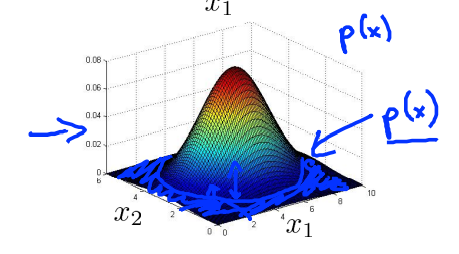
但是怎么选择 \(\epsilon\) 呢?这就得用到实际的标签了。这就是说为什么它既是无监督学习,也有一点监督学习的味道。
1.2 Developing and evaluating an anomaly detection system.
When developing a learning algorithm (choosing features, etc.), making decisions is much easier if we have a way of evaluating our learning algorithm.
Assume we have some labeled data, of anomalous and non-anomalous examples. (\(y=0\) if normal, \(y=1\) if anomalous).
Training set: \(x^{(1)},...,x^{(m)}\) assume normal examples/not anomalous)
In anomaly detection, we fit a model \(p(x)\) to a set of negative \((y=0)\) examples, without using any positive examples we may have collected of previously observed anomalies.We want to model "normal" examples, so we only use negative examples \((y=0)\;normal\) in training.
Cross validation set: \((x^{(1)}_{cv},y^{(1)}_{cv}), (x^{(2)}_{cv},y^{(2)}_{cv}), ..., (x^{(m)}_{cv},y^{(m)}_{cv})\)
Test set: \((x^{(1)}_{test},y^{(1)}_{test}), (x^{(2)}_{test},y^{(2)}_{test}), ..., (x^{(m)}_{test},y^{(m)}_{test})\)
1.2.1 For an Aircraft engines motivating example:
10000 good(normal) engines
20 flawed engines(anomalous)
Training set: 6000 good engines
CV: 2000 good engines (\(y=0\)), 10 anomalous (\(y=1\))
Test: 2000 good engines (\(y=0\)), 10 anomalous (\(y=1\))
Fit model \(p(x)\) on training set \(x^{(1)},...,x^{(m)}\)
On a cross validation/test example \(x\), predict
1 \; if \; p(x) < \epsilon \; \text{anomaly}\\
0 \; if \; p(x) \geq \epsilon \; \text{normal}\\
\end{matrix}\right.
\]
Give an parameter \(\epsilon\), find metrics:
- True positive, false positive, false negative, true negative.
- Rrecision/Recall
- F1-score
对于一系列的 \(\epsilon\),选择最大值的F1-score
rec \; = \frac{tp}{tp+fn}\\
F_1 \; = \frac{2 \cdot prec \cdot rec}{prec+rec}
\]
where
- \(tp\) is the number of true positives: the ground truth label says it’s an
anomaly and our algorithm correctly classified it as an anomaly. - \(fp\) is the number of false positives: the ground truth label says it’s not
an anomaly, but our algorithm incorrectly classified it as an anomaly. - \(fn\) is the number of false negatives: the ground truth label says it’s an
anomaly, but our algorithm incorrectly classified it as not being anomalous.
tp = sum((predictions==1) & (yval==1));
fp = sum((predictions==1) & (yval==0));
fn = sum((predictions==0) & (yval==1));
1.3 Anomaly detection vs. supervised learning
| Anomaly detection | Supervised Learning |
|---|---|
| Very small number of positive examples \((y=1)\). ( 0-20 or 0-50 is common). Large number of negative \((y=0)\)examples. | Large number of positive and negative examples. |
| Many different “types” of anomalies. Hard for any algorithm to learn from positive examples what the anomalies look like; future anomalies may look nothing like any of the anomalous examples we've seen so far. | Enough posi-ve examples for algorithm to get a sense of what positive examples are like, future positive examples likely to be similar to ones in training set. |
| Fraud detection | Email spam classification |
| Manufacturing(e.g. aircraft engines) | Weather prediction(sunny/rainy/tec) |
| Monitoring machines in a data center | Cancer classification |
1.4 Multivariate Gaussian distribution
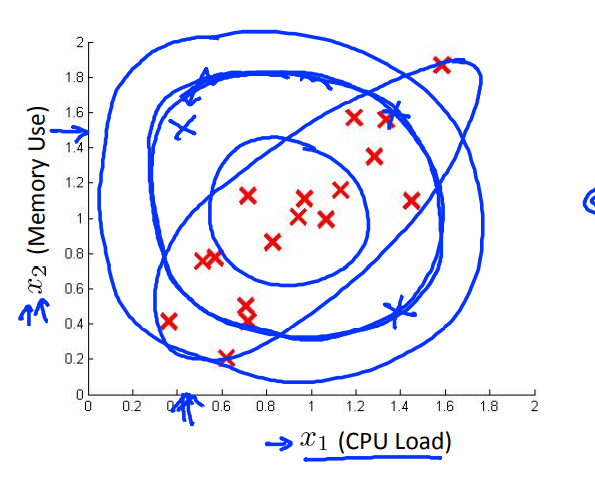
这种斜方向的分布是普通的高斯分布拟合不出来的,所以就要用到 Multivariate Gaussian distribution。
1.4.1 Algorithm
- Fit Model \(p(x)\) by setting
\(x^{(1)},...,x^{(m)}\)
\(\mu =\frac{1}{m} \sum_{i=1}^{m} x^{(i)}\)
\(\Sigma = \frac{1}{m} \sum_{i=1}^{m}(x^{(i)}-\mu)(x^{(i)}-\mu)^T\) - Given a new example \(x\), compute
\]
Flag an anomaly if \(p(x)< \epsilon\)
下面是一些图片,注意\(\Sigma\)矩阵的斜对角元素,以及正负。 形状会比普通的高斯分布多一点。普通高斯分布对应\(\Sigma\)矩阵的斜对角元素为0的情况。

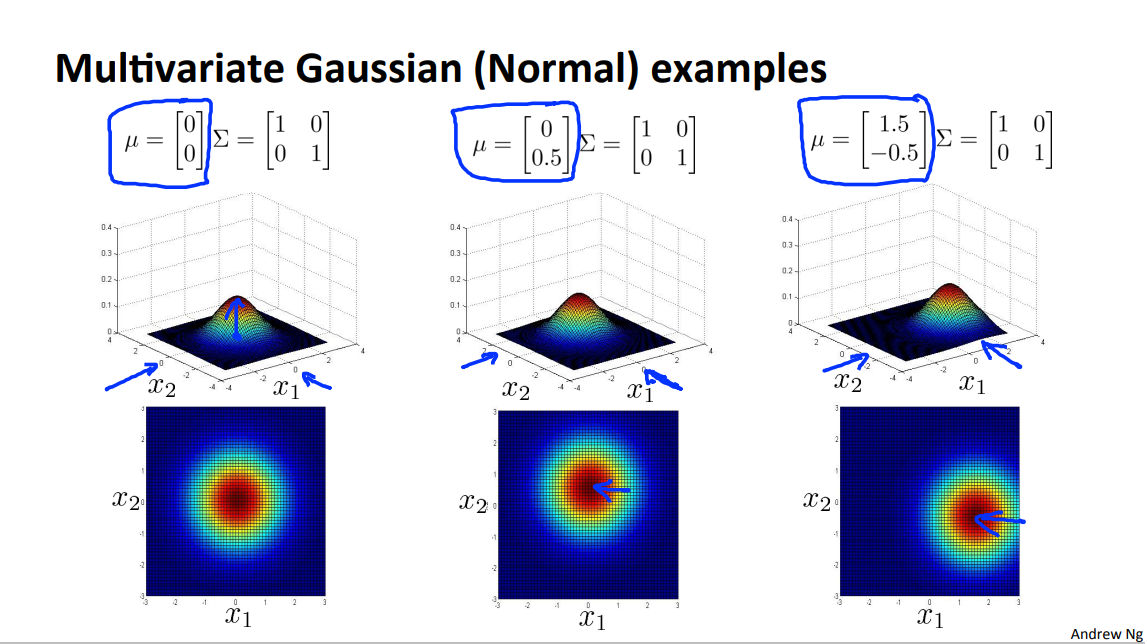

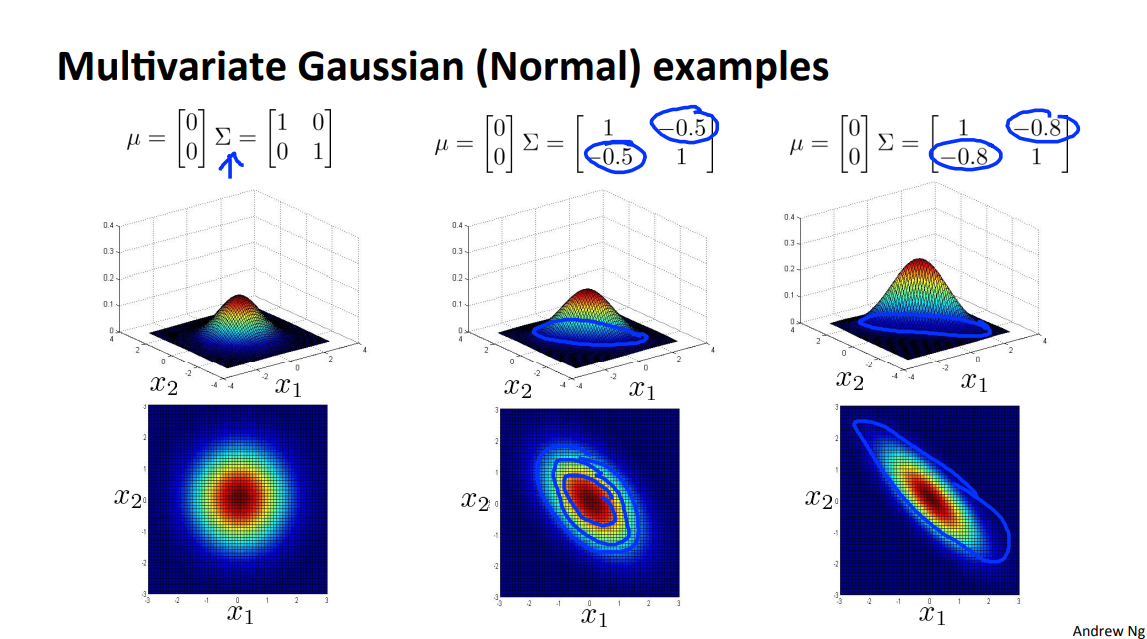
Orginal Model
\(P(x) = P(x_1;\mu_1 , \sigma^2_1)P(x_2;\mu_2 , \sigma^2_2) \cdots P(x_n;\mu_n , \sigma^2_n)\)
Manually create features to capture anomalies where \(x_1,x_2\) take unusual combinations of
values.Computationally cheaper ( alternatively, scales better to large n)
OK even if \(m\) training set size) is small
Multivariate Guassian
\(p(x;\mu, \Sigma) = \frac{1} {|\Sigma|^{\frac{1}{2}} (2\pi)^{\frac{n}{2}}} exp(-\frac{1}{2}(x -\mu)^T \Sigma^{-1}(x-\mu))\)
Automatically captures correlations between features
Computationally more expensive
Must have \(m>n\) , or else \(\Sigma\) is non-invertible.
2 Rcommender system
2.1 Problem Formulation
In this next set of videos, I would like to tell you about recommender systems. There are two reasons, I had two motivations for why I wanted to talk about recommender systems.
The first is just that it is an important application of machine learning. Over the last few years, occasionally I visit different, you know, technology companies here in Silicon Valley and I often talk to people working on machine learning applications there and so I've asked people what are the most important applications of machine learning or what are the machine learning applications that you would most like to get an improvement in the performance of. And one of the most frequent answers I heard was that there are many groups out in Silicon Valley now, trying to build better recommender systems.
So, if you think about what the websites are like Amazon, or what Netflix or what eBay, or what iTunes Genius, made by Apple does, there are many websites or systems that try to recommend new products to use. So, Amazon recommends new books to you, Netflix try to recommend new movies to you, and so on. And these sorts of recommender systems, that look at what books you may have purchased in the past, or what movies you have rated in the past, but these are the systems that are responsible for today, a substantial fraction of Amazon's revenue and for a company like Netflix, the recommendations that they make to the users is also responsible for a substantial fraction of the movies watched by their users. And so an improvement in performance of a recommender system can have a substantial and immediate impact on the bottom line of many of these companies.
Recommender systems is kind of a funny problem, within academic machine learning so that we could go to an academic machine learning conference, the problem of recommender systems, actually receives relatively little attention, or at least it's sort of a smaller fraction of what goes on within Academia. But if you look at what's happening, many technology companies, the ability to build these systems seems to be a high priority for many companies. And that's one of the reasons why I want to talk about them in this class.
The second reason that I want to talk about recommender systems is that as we approach the last few sets of videos of this class I wanted to talk about a few of the big ideas in machine learning and share with you, you know, some of the big ideas in machine learning. And we've already seen in this class that features are important for machine learning, the features you choose will have a big effect on the performance of your learning algorithm. So there's this big idea in machine learning, which is that for some problems, maybe not all problems, but some problems, there are** algorithms that can try to automatically learn a good set of features for you.** So rather than trying to hand design, or hand code the features, which is mostly what we've been doing so far, there are a few settings where you might be able to have an algorithm, just to learn what feature to use, and the recommender systems is just one example of that sort of setting. There are many others, but engraved through recommender systems, will be able to go a little bit into this idea of learning the features and you'll be able to see at least one example of this, I think, big idea in machine learning as well.
2.2
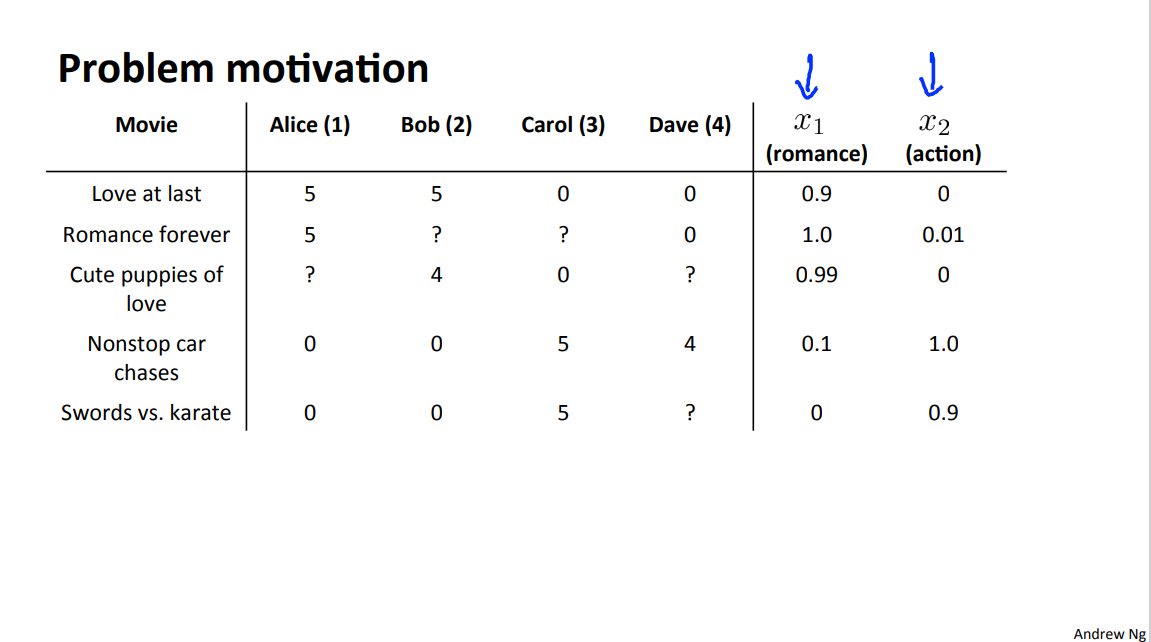
- \(n_u\) = no.users
- \(n_m\) = no.movies
- \(r(i,j)\) = 1 if user j has rated movie i
- \(y^{(i,j)}\) = rating given by user j to movie i (defined only if \(r(i,j)\) = 1)
- \(\theta^{(j)}\) = parameter vector for user j
- \(x^{(i)}\) = feature vector form movie i
For user j movie i, predicted rating:\((\theta^{(j)})^T(x^{(i)})\)
2.2.1 Optimization objective:
- To learn \(\theta^{(j)}\) (parameter for user \(j\)):
\]
只用用户评价过的电影来计算代价函数,\(i:r(i,j)=1\), 但是在一个矩阵运算中,评没评过都一块算了,但是算完没评过的就得置0. 没评价过的就记为0了。同时对应的导数值也为0。设置为0之后, 相加,相减就不影响了。
- To learn \(\theta^{(1)}\), \(\theta^{(2)}\),..., \(\theta^{(n_u)}\)
\]
- Given \(\theta^{(1)}\), \(\theta^{(2)}\),..., \(\theta^{(n_u)}\), To learn \(x^{(i)}\) (parameter for movie \(i\)):
\]
- Given \(\theta^{(1)}\), \(\theta^{(2)}\),..., \(\theta^{(n_u)}\), To learn \(x^{(i)}\),...,\(x^{(n_m)}\) (parameter for movie \(i\)):
\]
Collaborative filtering optimization objective
Minimizing \(\theta^{(1)}\), \(\theta^{(2)}\),..., \(\theta^{(n_u)}\) and \(x^{(i)}\),...,\(x^{(n_m)}\) simutaneously
\]
Collaborative filtering algorithm
- Initialize \(\theta^{(1)}\), \(\theta^{(2)}\),..., \(\theta^{(n_u)}\), \(x^{(i)}\),...,\(x^{(n_m)}\) to small random values.
- Minimize \(J(\theta^{(j)},...,\theta^{(n_u)},x^{(1)},...,x^{(n_m)})\) using gradient descent . (Linear regression)
- For a user with parameters \(\theta\) and a movie with (learned) features x, predict a star rating of \(\theta^Tx\).
J = (1/2) * sum(sum(((X*Theta' - Y).^2) .* R)) + (lambda/2)*sum(sum(Theta.^2)) + (lambda/2)*sum(sum(X.^2));
X_grad = (Theta' * ((Theta * X' - Y').* R'))' + lambda * X;
Theta_grad = (X' * ((X * Theta' - Y).* R ))' + lambda * Theta;
Reference
Andrew NG. Coursera Machine Learning Deep Learning. WEEK9.
文章会随时改动,要到博客园里看偶。一些网站会爬取本文章,但是可能会有出入。公式很难敲泪目。
转载请注明出处哦( ̄︶ ̄)
https://www.cnblogs.com/asmurmur/
Machine Learning Week_9 Anomaly Detection and Recommend System的更多相关文章
- Machine Learning - XV. Anomaly Detection异常检測 (Week 9)
http://blog.csdn.net/pipisorry/article/details/44783647 机器学习Machine Learning - Andrew NG courses学习笔记 ...
- machine learning 之 Anomaly detection
自Andrew Ng的machine learning课程. 目录: Problem Motivation Gaussian Distribution Algorithm Developing and ...
- Machine Learning and Data Mining(机器学习与数据挖掘)
Problems[show] Classification Clustering Regression Anomaly detection Association rules Reinforcemen ...
- How do I learn machine learning?
https://www.quora.com/How-do-I-learn-machine-learning-1?redirected_qid=6578644 How Can I Learn X? ...
- Machine Learning for Developers
Machine Learning for Developers Most developers these days have heard of machine learning, but when ...
- 100 Most Popular Machine Learning Video Talks
100 Most Popular Machine Learning Video Talks 26971 views, 1:00:45, Gaussian Process Basics, David ...
- ADVICE FOR SHORT-TERM MACHINE LEARNING RESEARCH PROJECTS(短期机器学习研究的建议)
– Tim Rocktäschel, Jakob Foerster and Greg Farquhar, 29/08/2018 Every year we get contacted by stude ...
- [GPU] Machine Learning on C++
一.MPI为何物? 初步了解:MPI集群环境搭建 二.重新认识Spark 链接:https://www.zhihu.com/question/48743915/answer/115738668 马铁大 ...
- Time Series Anomaly Detection
这里有个2015年的综述文章,概括的比较好,各种技术的适用场景. https://iwringer.wordpress.com/2015/11/17/anomaly-detection-concep ...
- (原创)Stanford Machine Learning (by Andrew NG) --- (week 9) Anomaly Detection&Recommender Systems
这部分内容来源于Andrew NG老师讲解的 machine learning课程,包括异常检测算法以及推荐系统设计.异常检测是一个非监督学习算法,用于发现系统中的异常数据.推荐系统在生活中也是随处可 ...
随机推荐
- 关于没使用Mybatis 分页,分页sql默认执行count(0) 的问题
之前的Impl 的方法 :selectFromList(String uid, Integer pageNum, Integer pageSize) 之后的Impl 的方法 :selectFromLi ...
- HTTP 常见状态码【5种最最最常见的状态码】
HTTP 常见状态码 一.200 [ok] 一切正常 二.400 [Bad Request] 客户端 出现问题 需要注意:前端传入的参数与后台接收数据时的 参数名 必须保持一致 三.500 [Inte ...
- 1000T的文件怎么能快速从南京传到北京?最佳方案你肯定想不到
今天刷面试题看到一个有意思的面试题, 1000T的文件怎么能以最快速度从南京传到北京? 网络传输 首先我们考虑通过网络传输,需要多长时间. 我特地咨询了在运营商工作的同学,目前带宽: 家庭宽带下行最大 ...
- vue 根据div id 滚动到指定view到可视视图中
<div id="name" @click="scrollToViewById('name')"> ...... </div> scro ...
- Opensack-T版脚本安装
openStack-train 搭建部署 项目环境: 主机名 外网口(net) 内口(仅主机)s 配置 controller 192.168.220.10/192.168.220.1/24 192.1 ...
- JS处理html的编码(encode)与解码(decode)
一.用浏览器内部转换器实现转换 代码: var HtmlUtil = { // 1.用浏览器内部转换器实现html编码 htmlEncode: function(html) { // 创建一个元素容器 ...
- Angular 18+ 高级教程 – Reactive Forms
前言 上一篇的 Ajax 和这一篇的表单 (Form) 都是前端最最最常见的需求. 为此,Angular 分别提供了两个小型库来帮助开发者实现这些需求: Ajax – HttpClient Form ...
- TypeScript – Get Started
前言 我学 TypeScript 的时候是 Angular 2.0 beta 的年代... 现在 Angular 都快 14 了. 但由于已经有 1 年半没有写 Angular 和 TypeScrip ...
- Identity – Permission Claims & UserClaimsPrincipalFactory
前言 在 Identity – Authorize 有介绍过, Identity 的验证核心是 Claims. 在 Identity – Without Identity Framework 也看到了 ...
- 利用AutoGpt将任何模型支持o1模型的推理实现
利用AutoGpt将任何模型支持o1模型的推理实现 相信大家都对于OpenAI最新出的o1模型都非常关注,它已经能通过推理让回复的效果更加理想, 但是目前o1的限制太大,而且使用o1至少也是需要购买O ...
